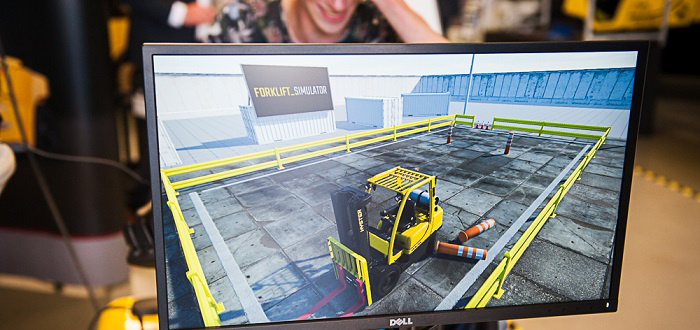-
ROSSLARE EUROPORT TARGETS HEALTH & SAFETY WITH CAMERA TELEMATICS PARTNERSHIP - 2 days ago
-
Landmark Study Reveals Wearable Robotics Significantly Boost Safety and Efficiency in Industrial Environments - July 24, 2024
-
Visku Tackle The Retail Seasonality Challenge One Pallet At A Time - July 22, 2024
-
KAMMAC AND BERGEN LOGISTICS STRENGTHEN FASHION & LIFESTYLE SERVICES IN THE UK - July 19, 2024
-
TENTBOX EXTENDS PARTNERSHIP WITH ARROWXL TO SUPPORT INCREASING DEMAND - July 17, 2024
-
The Perfume Shop improves customer journeys while driving profitability in partnership with Scurri - July 17, 2024
-
ZEROMISSION SECURES £2.3M ($3M) INVESTMENT TO ACCELERATE ELECTRIC FLEETS - July 16, 2024
-
BCMPA CELEBRATES SUCCESS OF 2024 CONFERENCE - July 15, 2024
-
Best of the Best: Jungheinrich Celebrates Triple International Award Win - July 12, 2024
-
GOPLASTICPALLETS.COM CALLS ON NEW CHANCELLOR RACHEL REEVES TO CONSIDER PLASTIC PACKAGING TAX REFORM - July 10, 2024
TRAINING AND FORKLIFT SIMULATION. A MATCH MADE IN… THE WAREHOUSE?
Hyster is exploring the benefits of using a forklift simulator in response to a growing number of companies interested in using simulation as part of their training programmes.
“Today’s forklift simulation technology provides the user with an immersive, full 3D environment combined with the actual controls and responses of a real lift truck,” says Robbert Wijnandts, Commercial Trainer for Hyster Company. “Even the toughest operating conditions can be simulated with the virtual forklift to give a real driving experience.”
The new Hyster Simulator has the same seat as featured on the Hyster® Fortens® model, the same pedals, steering wheel, CANBus and hydraulic controls. The user wears a VR headset (360° Oculus stereoscopic goggles) and as their head turns it gives different views through the mast, up, down and to the side, while spectators watch the activity on a screen. The software can also be customised to create experiences with different masts and attachments, such as paper clamps.
“The resistance and feeling is almost exactly the same as the real thing, but the act of moving loads is of course in a risk-free “gaming” environment,” he says. “There are many uses for this technology deployed in the right way for the right businesses, from introducing people to the driving experience at an event, through to integrating it into training programmes.”
Robbert explains that some critics argue that simulation is not “hands on”, unnecessary and not realistic to the actual equipment, but he says those arguments miss the point as to what simulation can do. Simulator training aims to reduce training costs and any associated risks, particularly early in the training journey.
To operate a lift truck in a live environment, there should typically be three stages to the training, beginning with Basic Operator Training (learning the basics about controls, hydraulics, safety etc.) followed by Specific Job Training (related to the equipment they will actually be using, and any attachments) and lastly Familiarisation Training where the operator is introduced to the actual live operation for the first time.
A mix of classroom based theory and practical training is typically used to train operators in as little as three days with tens of thousands of operators trained this way each year.
Robbert suggests that forklift simulators can now be used throughout this learning journey, by training departments looking to increase trainee engagement, reduce cost and improve safety. It will suit big organisations who deliver training on-site and larger external training providers, with the benefit that they can train a greater number of operators. The simulator has many different settings so it can be used as a tool within different training programmes, from a fun awareness activity for non-operators, through to more detailed training sessions for skilled drivers.
“Rather than going straight to the training area, learning can be accelerated by building the trainees’ muscle memory in the classroom and improving their awareness of space and hazards from the outset,” he says, explaining that the pallet-sized unit is easy to set up.
“Lift truck simulators can aid and assist Basic Training but should never be considered as a replacement for this essential stage,” explains Nick Welch, Technical Director for RTITB, the preferred workplace transport training accrediting body. “However, they can have a place in Specific Training (as described in ACOP L117) and would add great value to the process. The other area where simulation can add significant value is in the assessment of an existing operator’s ability and competence.”
However, it is not just about training the operators. Simulation can be used to find new potential drivers and give familiarisation training to warehouse operatives, supervisors and managers, providing greater awareness of what drivers can see, and educate about risk. It can also help with more regular refresher training, in the introduction of new safety initiatives, and to deal with issues such as complacency and bad habits.
“Daily routine and time pressures can make people forget what they learnt on their initial training,” Robbert says. “Regular monitored simulation can help re-establish motivation and tests in various scenarios can help drive behavioural change leading to better productivity.”
For more information about Hyster, visit :www.hyster.com

































